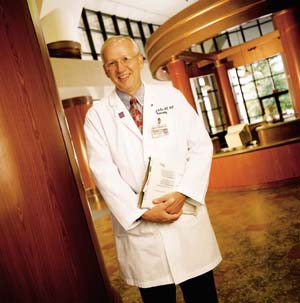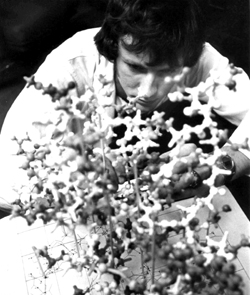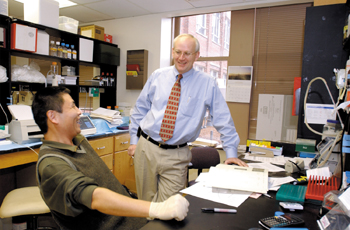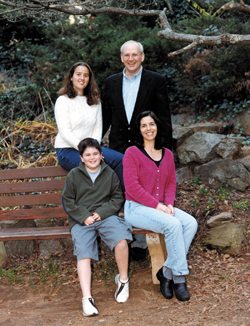
Dr. Raymond DuBois is internationally known as an investigator in the link between colon cancer, arthritis drugs and an enzyme called cyclooxygenase-2 (COX-2). (photo by Dean Dixon)
Roping an interest — Rodeo scholarship spurs career of top VUMC scientist

DuBois examines a model molecular structure during his early days as a researcher.

Dr. Ray DuBois talks with Ding-Zhi Wang, Ph.D., research associate professor of Medicine, in his lab. (photo by Dana Johnson)

The DuBois Family: Ray, Lisa, Shelley and Ethan.
In the past nine months, Dr. Raymond N. DuBois has won a major cancer research award, given lectures in Stockholm, Amsterdam and Rome, and — along with Vanderbilt colleague Lynn M. Matrisian, Ph.D. — been appointed to the National Cancer Institute’s Board of Scientific Advisors.
Not bad for a kid from Runge, Texas, population 800.
The son of an oil field “roughneck” and roadside icehouse operator, DuBois initially planned to make his living in agriculture. But while attending Texas A&M University in the early 1970s, he discovered biochemistry and a love of science that would take him far away from rural life and South Texas.
Eventually, he found his way to Vanderbilt University Medical Center, and to an avenue of research that has brought him international attention and acclaim — the link between colon cancer, arthritis drugs and an enzyme called cyclooxygenase-2 (COX-2).
In the early 1990s, DuBois and his colleagues reported that colorectal tumors contained high levels of the COX-2 enzyme, and that tumors shrank if the enzyme was blocked. Their work helped lead to the successful treatment of pre-cancerous colorectal polyps with an arthritis drug that selectively inhibits COX-2 and, some would argue, to a new field of “chemo-prevention.”
“Whenever you think about COX-2 and cancer prevention, the first person who comes to your mind is Ray,” says Dr. Curtis C. Harris, chief of the laboratory of human carcinogenesis at the National Cancer Institute. “He’s spectacular.”
DuBois, who has a Ph.D. in biochemistry as well as a medical degree, is continuing to study the mechanisms by which the COX-2 enzyme may trigger cancer growth, and how blocking the enzyme may prevent it. He also has taken a leadership role in plotting the course of cancer research, both at Vanderbilt and nationally.
Curiosity and the desire to improve the lives of his patients are major sources of motivation for DuBois, 48. “I continue to get very excited when we find out more information about what makes cancer cells different from normal cells, and how we can take advantage of those differences in devising new therapeutic or prevention options,” he says.
Silver-haired and soft-spoken, DuBois is intense about his work but generous with his time. “He is not arrogant or pretentious,” says Nashville vascular surgeon Dr. David B. Dunn, a close friend since they attended medical school together in the early 1980s. “He’s down-to-earth. He’s still the Ray I knew from small-town Texas.”
DuBois says he might still be living in that small town about 75 miles southeast of San Antonio were it not for the Houston Livestock Show and Rodeo college scholarship that enabled him to go to Texas A&M University (originally the Agricultural and Mechanical College of Texas) in College Station.
The certificate still hangs on his office wall. “It’s probably the most important award that I ever got,” says DuBois, who has four siblings. “There was just no way my parents could pay for college.”
DuBois was eligible to apply for the scholarship because he’d raised steers for a Future Farmers of America (FFA) project, and showed them at the Houston Livestock Show and Rodeo. He also was near the top of his high school class of 16 students. “It was a full scholarship,” he says. “The only stipulation was you had to major in some field of agriculture, and you had to go to some school in Texas.”
DuBois initially majored in agricultural education, but soon switched to a more challenging field of study — an honors program in biochemistry. “I did a lot of research in the library,’’ he recalls, “and came upon this textbook on the molecular basis for medicine. I had no experience in medicine, no experience in science — it just really intrigued me that these biomolecules were known to exist and could play a role in disease.”
One of his projects, in 1976, involved the isolation of epidermal growth factor, which had been discovered a few years earlier by Nobel Prize-winning biochemist Stanley Cohen of Vanderbilt. “I remember reading Dr. Cohen’s original paper on that, and I actually followed his protocol … and it worked!” DuBois says.
No fear
“That became kind of an eye-opening experience for Raymond, to see that we could actually control and regulate cell growth,” recalls E.D. Harris, Ph.D., professor of biochemistry and nutrition at Texas A&M, who supervised DuBois’ early research projects.
“We really try to take textbook knowledge and put it into more practical use,” Harris continues. “Formulating hypotheses, setting up experiments, kind of matching wits with Nature is what we tell (students) …
“If you get out of bed on Monday morning and come running into the lab to see how your experiment came out, there is something inside of you that turns you on,” he says. “Raymond was that kind.”
In 1977, after he earned his bachelor’s degree, DuBois continued his education at the University of Texas Southwestern Medical Center at Dallas. There he received an award from the American Liver Foundation to study enzymes that play important roles in the metabolism of drugs and toxins in the liver.
His dissertation advisor was Michael R. Waterman, Ph.D., now Natalie Overall Warren Distinguished Professor and Chair of Biochemistry at Vanderbilt.
“The thing I remember most about Ray is that he had no fear in trying new experiments,” Waterman says. “Many students are somewhat reluctant to try new methods, … (but) Ray has always had this self-confidence that he could do anything he wanted to do. That was probably the side of his personality that made him so successful as a scientist.”
Waterman says that DuBois has a “killer instinct” to do whatever experiments are necessary to answer the scientific questions, and to make sure that the results are published in scientific journals so they can be shared with other researchers.
“That’s a very important part of being a scientist,” Waterman says. “Just being smart and … being able to ask important questions isn’t necessarily enough. You have to be a finisher. And Ray is an excellent finisher.”
During this time DuBois met Lisa Abrams, who was working as a part-time photographer in the biochemistry department while studying for her master’s degree in biomedical communications. They married in 1980.
DuBois became interested in translating bench research into clinical medicine, so after he earned his Ph.D. in 1981, he enrolled in medical school at the University of Texas Health Science Center at San Antonio.
Waterman admits he was disappointed when DuBois decided to go to medical school. “I thought we would never see Ray in the laboratory again,” he says. “I think I miscalculated Ray’s commitment to science in those days. It was deeper than I had actually realized.”
Thanks to Dr. Raymond F. Burk, at the time a professor of medicine at UT, DuBois continued to work in the laboratory during the summers of his medical school years. Burk also recommended several post-M.D. clinical training programs, including Johns Hopkins University School of Medicine, which DuBois chose for his residency and fellowship in internal medicine and gastroenterology.
“You never can tell how much influence you have on somebody but … my philosophy has always been to try to facilitate things for folks who were working with me,” says Burk, currently professor of Medicine and Pathology at Vanderbilt.
1985 was a year of dramatic change for the DuBoises. Their first child, Shelley, was born, the family moved to Baltimore, and Lisa DuBois switched her career to freelance journalism.
Her assignments included writing for an independently produced radio health program, called “The Heart of the Matter.” Some of her reports were broadcast on National Public Radio stations around the country. She also was a regular writer and producer for the educational branch of Baltimore’s PBS television affiliate, and wrote and directed the park video for the Badlands National Park in South Dakota.
In 1989, their son Ethan was born.
The cancer connection
In the late 1980s, DuBois got a chance to work in the lab of Dr. Daniel Nathans, a Nobel Prize-winning geneticist at Johns Hopkins who died in 1999.
“It was so important,” he says. “I had the early training, the Ph.D. in biochemistry, all the clinical training, and during that two-and-a-half-year period in his lab, I could put it all together, and see how basic science can apply to real clinical disease.”
DuBois started working with genes that are involved in the regulation of cell growth — and in abnormal growth (cancer). “We cloned a number of genes that were turned on in cells that were proliferating,” he says. “That led ultimately to my interest in COX-2.”
Cyclooxygenase is a family of enzymes that catalyze the production of powerful substances called prostaglandins. These fatty-acid molecules exert a wide range of effects, from inflammation and healing wounds, to forming blood clots and promoting cancer growth.
By the early 1990s, researchers had determined that prostaglandin production by one of the enzymes, called COX-1, protects the stomach lining, whereas activation in other tissues of a related enzyme, COX-2, can lead to inflammation, pain and tumor growth.
The finding led to the development and the marketing of the blockbuster arthritis drugs Celebrex and Vioxx, which specifically inhibit the COX-2 enzyme without affecting the activity of COX-1. The goal is to relieve pain and inflammation without causing stomach upset and ulcers, a problem with other non-steroidal, anti-inflammatory drugs that block both enzymes.
As early as 1991, researchers noted that people who took aspirin on a regular basis had a 40 percent to 50 percent drop in the relative risk of developing colorectal cancer. This finding intrigued DuBois, who that year had completed his fellowship and was weighing offers for faculty appointments at Johns Hopkins, Duke University, the University of Iowa — and Vanderbilt.
Ultimately he was swayed by the persuasiveness of Burk, who had moved from UT to Vanderbilt in 1987 to direct the division of Gastroenterology, and by Dr. John A. Oates, at the time chairman of Medicine. In addition, Dr. Harold L. Moses, founding director of the Vanderbilt-Ingram Cancer Center who was chairman of Cell Biology, offered DuBois a joint faculty position in his department.
The joint appointment in Cell Biology “allowed me to have graduate students, which really helped out with my research program,” DuBois says. He also benefited from the expertise of several of his Vanderbilt colleagues, who are nationally known for their work on prostaglandins and growth factors. “It’s uncanny how some of these things worked out,” he says.
At Johns Hopkins, DuBois had started to clone genes that were dramatically “up-regulated” following growth stimulation. He continued that work at Vanderbilt, with a focus on growth factor-regulated genes in intestinal epithelial cells. “The most common one turned out to be (the gene for) COX-2,” he says. “I thought it was curious that it was there … so we started looking in intestinal cancers to see if it was elevated.”
In 1994, DuBois and his colleagues found high levels of COX-2 in cancerous colon tissue. In later studies, they showed the enzyme causes changes in cells grown at the lab that enhance the potential for cancer to develop.
Another important brick in the knowledge base was tapped into place in 1997, when the DuBois team stopped human colon cancer cells from growing in the laboratory by blocking the COX-2 enzyme. Seizing on that and other discoveries, researchers began testing Celebrex in patients with familial adenomatous polyposis, multiple polyps in the colon that nearly always become malignant.
In June 2000, an international team of researchers, including DuBois, reported that the use of Celebrex led to a significant reduction in the number of polyps in patients with the inherited condition. Results of the study, conducted at University of Texas M.D. Anderson Cancer Center in Houston and St. Mark’s Hospital in London, were published in The New England Journal of Medicine.
Dr. Lee Nadler, a prominent cancer researcher at Harvard Medical School, summed up DuBois’ contributions to the field last April, when he presented him with the Richard and Hinda Rosenthal Foundation Award during the American Association for Cancer Research’s annual meeting in San Francisco:
“In 1997, Ray first showed that human colon cancer cell growth could be inhibited by selective inhibition of COX-2, and that selected inhibitors of COX-2 could prevent carcinogenesis,” Nadler said.
“The demonstration in … 2000 that Celebrex inhibited familial adenomatous polyposis was a landmark,” Nadler said. “Ray was neither first nor last author on that paper, but it was his brilliance that led to this accomplishment.
“The world is now poised to prevent colon cancer using COX-2 inhibitors, and this work rests upon Ray’s shoulders.”
He directs the division of Gastroenterology, Hepatology and Nutrition at Vanderbilt, and the Vanderbilt Digestive Disease Research Center. He also is the Mina Cobb Wallace Professor of Gastroenterology and Cancer Prevention, and associate director of the Vanderbilt-Ingram Cancer Center for Cancer Prevention, Control and Population-based Research.
In addition to his recent appointment at the National Cancer Institute, DuBois is a member of the advisory committee to the director of the National Institute of Diabetes and Digestive and Kidney Diseases. He also serves on the medical advisory board for the National Colorectal Cancer Research Alliance, founded by NBC’s “Today” show co-anchor Katie Couric, Lilly Tartikoff and the Entertainment Industry Foundation to promote education, research and early screening for colon cancer.
Other talents
The Rosenthal Foundation Award is among a slew of recent honors DuBois has received for his scientific achievements. They include the Outstanding Investigator Award in Clinical Science from the American Federation for Medical Research, and admission to the Royal College of Physicians in London for “exceptionally distinguished contributions to the field of medicine.”
In addition to his expertise in the laboratory and clinic, DuBois is a gifted administrator. Since becoming director of the Division of Gastroenterology, Hepatology and Nutrition in 1998, “Ray has certainly carried things to another level,” says Burk, his predecessor. “His contribution has just been outstanding.”
“Ray has had a really meteoric rise in the last several years,” adds Dr. Frank Giardiello, director of the Division of Gastroenterology and Hepatology at Johns Hopkins who oversaw DuBois’ fellowship training. “He’s among a handful of major leaders in gastroenterology.” DuBois is a past president of the Gastroenterology Research Group of the American Gastroenterology Association, and the Southern Society for Clinical Investigation.
He also has become a sought-after speaker. Last fall, for example, DuBois was invited to discuss his research during a post-graduate program at Sweden’s Karolinska Institute, which awards the Nobel Prize in Physiology or Medicine.
“He can explain to a very sophisticated scientific audience or to a lay audience the importance of cancer research at all different levels,” says the National Cancer Institute’s Harris. “We need more people who have not only the scientific and clinical skills, but the communicative skills to explain (it) to the people who are actually paying for and benefiting from the research … Ray is one of these unique people who can do that.”
As her husband has become a frequent world traveler, Lisa DuBois has adapted her career to the demands of raising two teen-agers and renovating their house. In addition to freelance writing, she recently completed her first book, a historical novel.
DuBois is the first to admit that he and his colleagues have only scratched the surface about what is known — and what needs to be determined — about cancer in order to halt it successfully.
The belief that a single, “magic bullet” can be developed to cure cancer is naïve, he says. This may work in a situation where most of the cells are clonal, but the situation is much more complex in solid malignancies like breast, colon and lung cancer.
Some patients with a rare form of leukemia, for example, have developed “resistance” to Gleevec, a drug that blocks an enzyme necessary for the cancer cells to survive and grow. There are other, independent pathways that signal the cells to continue dividing.
“These are circuits, really,” DuBois says. “They’re complex circuits, just like electricity. And it’s a dynamic situation. We always get caught up in looking at a snapshot of one protein at one particular point in time, and trying to make some conclusion. In reality, things are on and off temporally, and they’re moving. It’s a fluid system.
“My feeling is that a single agent alone is not going to be the cure,” he continues. To successfully stop tumor growth, two or three independent pathways may have to be bombarded with specific inhibitors simultaneously.
“That is sort of where things are going,” DuBois says. “There are a lot of clinical trials underway with COX-2 inhibitors for prevention and treatment, but they’re being used now in combination with cytotoxic chemotherapy and with other targeted therapies like Iressa … It may be five to 10 years before we really get an effective cocktail.”
“The caveat that we have a long way to go is a valid one,” Harris agrees. At the same time, “the kind of studies Ray has done gives us all optimism that we’re on the right track.”
Harris says he has one worry about DuBois — that his administrative duties will prevent him from pursuing his research. But then he adds: “Ray’s a very savvy kind of individual. He’ll make the right choices that are best for him.
“Vanderbilt is very lucky to have him.”













